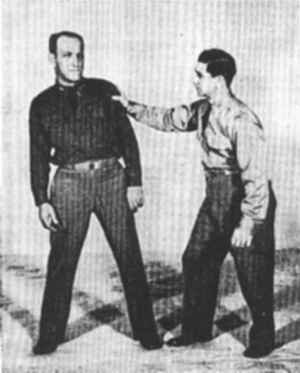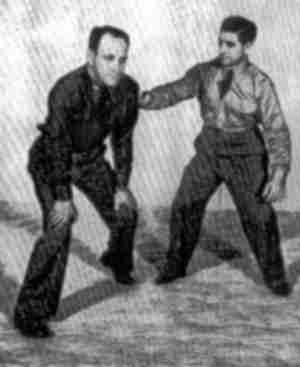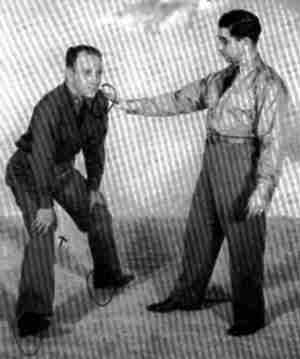
7. PRINCIPLES OF UNARMED DEFENSE. -- It is of the utmost importance that in order to learn unarmed defense in the manner necessary to use it effectively, the principles be first mastered.
a. The first principle is "balance." The accompanying illustrations will be used to point out the principle of balance. Figure 1-1 illustrates a man in balance with his legs apart. It is shown that the individual in this position is on balance from right to left and from left to right.

However, figure 1-2 shows that he is definitely off balance forward, and figure 1-3 shows that he is also off balance backward.


It is usually assumed that when an individual assumes the position of the charge he is on balance all the way around. Figure 2-1 shows that in a position of charge with the right foot forward, the individual is on balance from right front to left rear and from left rear to right front.

However, figure 2-2 shows that in this position he is off balance to the right rear, and figure 2-3 shows that he is off balance to the left front.


Notice the small amount of effort required to take an individual off balance when you know in what directions he is strong and in what directions he is weak. No matter what position an individual assumes, he is off balance in some direction.
b. The second principle is "use of the internal oblique muscles." These muscles have been named by the Japanese Shita-hara, pronounced "stahara." [EN1] The internal oblique muscles are located in the center of the body in the lower abdomen between the hipbones. The power for every defense must come or be centered in these muscles.
c. Principle three is the ability to utilize an opponent's momentum or an opponent's strength to bring about his downfall. You always assume that your opponent is stronger than you are and never attempt to oppose him directly, but rather utilize his impetus or momentum to carry him on his way, the difference being that you direct the movement.
d. Principle four is to attack your opponent on the spot where he is weakest with the greatest amount of power that you can concentrate on that one point. The axiom of this principle is "My maximum strength against your minimum." To illustrate this point, if an opponent were to grasp your wrist, instead of trying to tear your wrist from between his fingers by main strength of your arms, you would attempt to concentrate the power of your legs, body, and arms against his fingers.
e. The fifth and last principle is a knowledge of "the major and minor operations." This knowledge is essential to prevent injury while practicing. "The major operation" means either getting out of danger or getting the essential part of a hold. "The minor operation" is the application of the pressure. If both of these were run together, the results might be a broken bone or other serious injury to a partner. Therefore, in practice, be judicious and apply the "major and minor operations" separately.
Editor's Notes
EN1. For a more complete description of "stahara," see Allan Corstorphin Smith, The Secrets of Jujitsu, A Complete Course in Self Defense (Columbus, GA: Stahara Publishing Co., 1920), Book I, at http://ejmas.com/jnc/jncframe.htm.